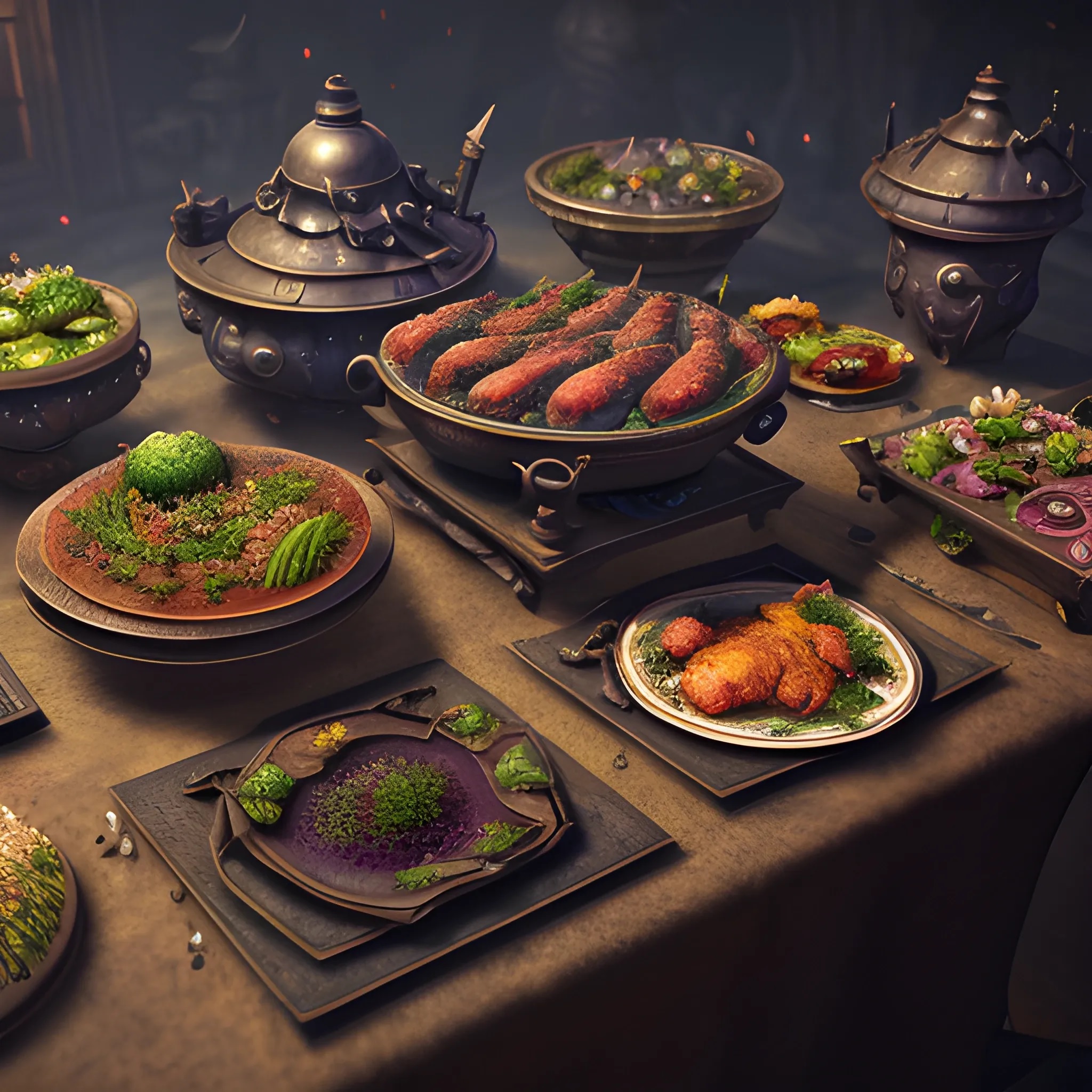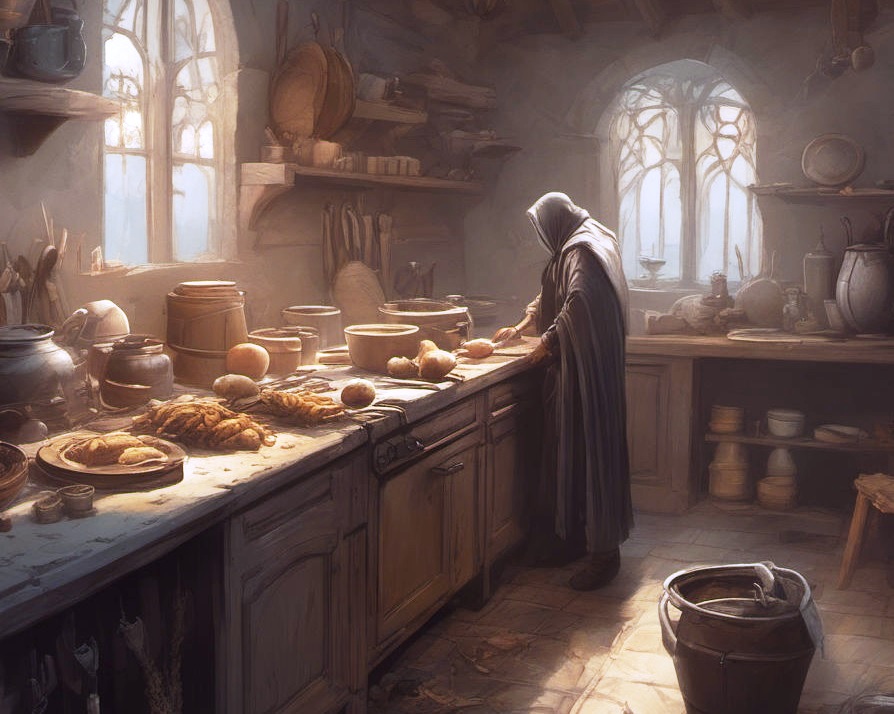Difference between revisions of "Nutrition & the Preparation of Food"
Tao alexis (talk | contribs) |
Tao alexis (talk | contribs) |
||
| Line 25: | Line 25: | ||
== Preparation == | == Preparation == | ||
There are six "standards" of preparing food, specifying limitations of space, utensils and equipment, the nature of the fire used and complimentary storage of edibles. Though a cook's hands are undoubtably the most important, having room to work in a fully equipped kitchen, where the air is kept fresh while particulates are kept to a minimum, are unquestionably necessary to the preparation of great dishes. Thus the circumstances in which food is prepared subsequently affects the diners' health and mood. | There are six "standards" of preparing food, specifying limitations of space, utensils and equipment, the nature of the fire used and complimentary storage of edibles. Though a cook's hands are undoubtably the most important, having room to work in a fully equipped kitchen, where the air is kept fresh while particulates are kept to a minimum, are unquestionably necessary to the preparation of great dishes. Thus the circumstances in which food is prepared subsequently affects the diners' health and mood. | ||
| + | |||
| + | === Cold Camp Fare === | ||
| + | This describes eating in the outdoors, effectively cooking in one's lap, without the benefit of fire or any other heat source. Methods focus on combining raw or minimally processed ingredients creatively to create dishes. This allows food to be cleaned with water and peeled, through the use of a knife or a scraping rock — and so food that is pounded, mashed or cut up is possible. However, without a fire, food cannot be safely blanched or boiled, nor can it be browned and sweetened. | ||
| + | |||
| + | Durables and staples, along with fresh vegetables, fruits, and bottled beverages, are best for cold camp cooking. Spices can be used but they have only a moderate effect on the food's taste. Meat must be eaten raw, for which fish is best. Some delicacies that have been pickled can be eaten in a cold camp, but without other viands some will have a terrible taste. Meals in a cold camp can be satisfying, but it takes a clever culinary expert to make them so. | ||
Revision as of 17:15, 12 August 2023
Nutrition and Preparation argues that the food consumed in the game world should vary in kind, so that apart from the amount of food that characters must consume, the taste and quality of the food should also matter. Characters cannot simply live on bread and water. They must eat, at the very least, "palatable food" — and, when possible, "good" food.
Contents
This isn't always easy while adventuring. The manner of food that can be obtained, and where it can be prepared, improves considerably in urban settings, where an interior kitchen is available. Food cooked in a camp, which must endure in a character's pack for days, is far less desirable and the value gained from eating such victuals deserve attention within the game's rules.
Food Goodness
A food's versatility and taste depends upon it's general caliber. Ordinary food, while resistant to spoiling, has little to offer as a meal, if not blended with more discerning or quality foods. Thus the "goodness" of a food describes it's capacity to entice the senses. There are five general standards of goodness: durables, staples, fresh foods, premium foods and delicacies.
Durables
These include preserved meats such as jerky, dry sausage, salt-pork, sauerkraut and dried fish; also potable plant products like polished rice and dried pulses; and forage such as dried mushrooms, grains, wild nuts, seeds and dried fruits. Food that is foraged falls into this category. Note that the category includes mainly unprepared foods, whereas "staples," below, include versions of these foods after processing. Durable foods may be edible after months have passed, and even years.
Staples
These include processed foodstuffs such as flour, refined salt, honey, cheese, butter and biscuits, root vegetables and tubers, and beverages such as ale, beer, mead, wine and distilled drink. The inclusion of these latter beverages especially raise the quality of the meal. As products, they generally have a lifespan of 2 to 8 months.
Fresh Foods
These include recently picked vegetables and fruits, butchered meats, whole or raw milk and cream, among others. For each there is a short time before the food spoils, before it is processed or cooked — in some cases as little as 2 days, in others as much as 12 days. Meanwhile, the wholeness of the food is in a state of constant decline, but may be "rescued" even after it's begun to go bad. Also included in the category, and having longer lifespans, are herbs such as basil, chamomile, cumin, dill, rosemary, parsley and sage, along with tea leaves and coffee beans. Note that in all cases, very fresh foods are considered "premium."
Premium Foods
These include fresh foods that have been picked or collected in the last 12 hours, including butchered meats. These also must be of the best nature, without bruising, blemishes or discolouration, and with regards to meat, butchered finely and from the choice parts of the animal. Premium foods that are allowed to linger become "fresh" when the 12-hour time period has past.
Delicacies
These include unusual dishes or foods that provide a complex dining experience, such as caviar, foie gras, eels, turtle, cicitt, suckling pig and many others. Unusual distilled spirits or wines also fall into this category. Each has a variable shelf life, though many are pickled or otherwise preserved due to their being transported over long distances.
Preparation
There are six "standards" of preparing food, specifying limitations of space, utensils and equipment, the nature of the fire used and complimentary storage of edibles. Though a cook's hands are undoubtably the most important, having room to work in a fully equipped kitchen, where the air is kept fresh while particulates are kept to a minimum, are unquestionably necessary to the preparation of great dishes. Thus the circumstances in which food is prepared subsequently affects the diners' health and mood.
Cold Camp Fare
This describes eating in the outdoors, effectively cooking in one's lap, without the benefit of fire or any other heat source. Methods focus on combining raw or minimally processed ingredients creatively to create dishes. This allows food to be cleaned with water and peeled, through the use of a knife or a scraping rock — and so food that is pounded, mashed or cut up is possible. However, without a fire, food cannot be safely blanched or boiled, nor can it be browned and sweetened.
Durables and staples, along with fresh vegetables, fruits, and bottled beverages, are best for cold camp cooking. Spices can be used but they have only a moderate effect on the food's taste. Meat must be eaten raw, for which fish is best. Some delicacies that have been pickled can be eaten in a cold camp, but without other viands some will have a terrible taste. Meals in a cold camp can be satisfying, but it takes a clever culinary expert to make them so.

